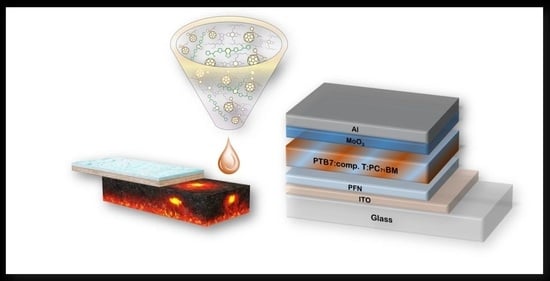Benzothiadiazole Based Cascade Material to Boost the Performance of Inverted Ternary Organic Solar Cells
Abstract
:1. Introduction
2. Materials and Methods
2.1. Materials and Instruments
2.2. Device Fabrication
3. Results and Discussion
3.1. Photophysical Properties
3.2. Photovoltaic Performance
3.3. Charge Transfer Properties
3.4. Morphology
4. Conclusions
Supplementary Materials
Author Contributions
Funding
Conflicts of Interest
References
- Cao, W.; Xue, J. Recent progress in organic photovoltaics: Device architecture and optical design. Energy Environ. Sci. 2014, 7, 2123–2144. [Google Scholar] [CrossRef]
- Li, Y.F. Molecular design of photovoltaic materials for polymer solar cells: Toward suitable electronic energy levels and broad absorption. Acc. Chem. Res. 2012, 45, 723–733. [Google Scholar] [CrossRef] [PubMed]
- Li, G.; Zhu, R.; Yang, Y. Polymer solar cells. Nat. Photon. 2012, 6, 153–161. [Google Scholar] [CrossRef]
- Mikroyannidis, J.A.; Stylianakis, M.M.; Sharma, G.D.; Balraju, P.; Roy, M.S. A novel alternating phenylenevinylene copolymer with perylene bisimide units: Synthesis, photophysical, electrochemical, and photovoltaic properties. J. Phys. Chem. C 2009, 113, 7904–7912. [Google Scholar] [CrossRef]
- Lu, L.; Yu, L. Understanding low bandgap polymer PTB7 and optimizing polymer solar cells based on it. Adv. Mater. 2014, 26, 4413–4430. [Google Scholar] [CrossRef]
- Mikroyannidis, J.A.; Stylianakis, M.M.; Suresh, P.; Roy, M.S.; Sharma, G.D. Synthesis of perylene monoimide derivative and its use for quasi-solid-state dye-sensitized solar cells based on bare and modified nano-crystalline ZnO photoelectrodes. Energy Environ. Sci. 2009, 2, 1293–1301. [Google Scholar] [CrossRef]
- Sharma, G.D.; Suresh, P.; Mikroyannidis, J.A.; Stylianakis, M.M. Efficient bulk heterojunction devices based on phenylenevinylene small molecule and perylene-pyrene bisimide. J. Mater. Chem. 2010, 20, 561–567. [Google Scholar] [CrossRef]
- Zhang, S.; Ye, L.; Hou, J. Breaking the 10% efficiency barrier in organic photovoltaics: Morphology and device optimization of well-known PBDTTT polymers. Adv. Energy Mater. 2016, 6, 1502529. [Google Scholar] [CrossRef]
- Guo, X.; Zhou, N.; Lou, S.J.; Smith, J.; Tice, D.B.; Hennek, W. Polymer solar cells with enhanced fill factors. Nat. Photon. 2013, 7, 825–833. [Google Scholar] [CrossRef]
- Liu, Q.; Toudert, J.; Li, T.; Kramarenko, M.; Martínez-Denegri, G.; Ciammaruchi, L.; Zhan, X.; Martorell, J. Inverse optical cavity design for ultrabroadband light absorption beyond the conventional limit in low-bandgap nonfullerene acceptor–based solar cells. Adv. Energy Mater. 2019, 9, 1900463. [Google Scholar] [CrossRef]
- Liu, Q.; Romero-Gomez, P.; Mantilla-Perez, P.; Colodrero, S.; Toudert, J.; Martorell, J. A two-resonance tapping cavity for an optimal light trapping in thin-film solar cells. Adv. Energy Mater. 2017, 7, 1700356. [Google Scholar] [CrossRef] [Green Version]
- Kakavelakis, G.; Vangelidis, I.; Jungemann, H.; Kanaras, A.G.; Lidorikis, E.; Stratakis, E.; Kymakis, E. Photovoltaic devices: Plasmonic backscattering effect in high-efficient organic photovoltaic devices. Adv. Energy Mater. 2015, 6, 1501640. [Google Scholar] [CrossRef]
- Noori, K.; Konios, D.; Stylianakis, M.M.; Kymakis, E.; Giustino, F. Energy-level alignment and open-circuit voltage at graphene/polymer interfaces: Theory and experiment. 2D Mater. 2016, 3, 015003. [Google Scholar] [CrossRef]
- Tiwari, S.; Tiwari, T.; Carter, S.; Scott, J.; Yakhmi, J. Advances in polymer-based photovoltaic cells: Review of pioneering materials, design, and device physics. In Handbook of Ecomaterials, 1st ed.; Martínez, L., Kharissova, O., Kharisov, B., Eds.; Springer: Cham, Switzerland, 2019; pp. 1055–1101. [Google Scholar]
- Huang, W.; Cheng, P.; Yang, Y.; Li, G.; Yang, Y. High-performance organic bulk-heterojunction solar cells based on multiple-donor or multiple-acceptor components. Adv. Mater. 2018, 30, 1705706. [Google Scholar] [CrossRef]
- Anagnostou, K.; Stylianakis, M.M.; Petridis, K.; Kymakis, E. Building an organic solar cell: Fundamental procedures for device fabrication. Energies 2019, 12, 2188. [Google Scholar] [CrossRef] [Green Version]
- Marrocchi, A.; Lanari, D.; Facchetti, A.; Vaccaro, L. Poly(3-hexylthiophene): Synthetic methodologies and properties in bulk heterojunction solar cells. Energy Environ. Sci. 2012, 5, 8457–8474. [Google Scholar] [CrossRef]
- Liang, Y.; Feng, D.; Wu, Y.; Tsai, S.T.; Li, G.; Ray, C.; Yu, L. Highly efficient solar cell polymers developed via fine-tuning of structural and electronic properties. J. Am. Chem. Soc. 2009, 131, 7792–7799. [Google Scholar] [CrossRef] [PubMed]
- Matsumoto, F.; Moriwaki, K.; Takao, Y.; Ohno, T. Synthesis of thienyl analogues of PCBM and investigation of morphology of mixtures in P3HT. Beilstein J. Org. Chem. 2008, 4, 33. [Google Scholar] [CrossRef]
- Li, C.Z.; Yip, H.L.; Jen, A.K.Y. Functional fullerenes for organic photovoltaics. J. Mater. Chem. 2012, 22, 4161–4177. [Google Scholar] [CrossRef]
- Berger, P.; Kim, R.; Kim, M. Polymer solar cells: P3HT: PCBM and beyond. J. Renew. Sustain. Energy 2018, 10, 013508. [Google Scholar] [CrossRef]
- Chen, C.P.; Lee, I.; Tsai, C.; Huang, Y.; Chen, C.L.; Huang, G.W. Efficient organic solar cells based on PTB7:PC71BM blend film with embedded different shapes silver nanoparticles into PEDOT: PSS as hole transporting layers. Org. Electron. 2018, 62, 95–101. [Google Scholar] [CrossRef]
- Cui, Y.; Yao, H.; Hong, L.; Zhang, T.; Tang, Y.; Lin, B.; Xian, K.; Gao, B.; An, C.; Bi, P.; et al. 17% efficiency organic photovoltaic cell with superior processability. Nat. Sci. Rev. 2019, nwz200. [Google Scholar] [CrossRef]
- Cui, Y.; Yao, H.; Zhang, J.; Zhang, T.; Wang, Y.; Hong, L.; Xian, K.; Xu, B.; Zhang, S.; Peng, J.; et al. Over 16% efficiency organic photovoltaic cells enabled by a chlorinated acceptor with increased open-circuit voltages. Nat. Commun. 2019, 10, 2515. [Google Scholar] [CrossRef] [PubMed]
- Fan, B.; Zhang, D.; Li, M.; Zhong, W.; Zeng, Z.; Ying, L.; Huang, F.; Cao, Y. Achieving over 16% efficiency for single-junction organic solar cells. Sci. China Chem. 2019, 62, 746–752. [Google Scholar] [CrossRef]
- Doumon, N.Y.; Dryzhov, M.V.; Houard, F.V.; Le Corre, V.M.; Rahimi Chatri, A.; Christodoulis, P.; Koster, L.J.A. Photostability of fullerene and non-fullerene polymer solar cells: The role of the acceptor. ACS Appl. Mater. Interfaces 2019, 11, 8310–8318. [Google Scholar] [CrossRef] [Green Version]
- Li, N.; McCulloch, I.; Brabec, C.J. Analyzing the efficiency, stability and cost potential for fullerene-free organic photovoltaics in one figure of merit. Energy Environ. Sci. 2018, 11, 1355–1361. [Google Scholar] [CrossRef] [Green Version]
- Liu, Q.; Toudert, J.; Liu, F.; Mantilla-Perez, P.; Bajo, M.M.; Russell, T.P.; Martorell, J. Circumventing UV light induced nanomorphology disorder to achieve long lifetime PTB7-Th:PCBM based solar cells. Adv. Energy Mater. 2017, 7, 1701201. [Google Scholar] [CrossRef] [Green Version]
- Lu, L.; Kelly, M.A.; You, W.; Yu, L. Status and prospects for ternary organic photovoltaics. Nat. Phot. 2015, 9, 491–500. [Google Scholar] [CrossRef]
- Gupta, V.; Bharti, V.; Kumar, M.; Chand, S.; Heeger, A.J. Polymer-polymer Förster resonance energy transfer significantly boosts the power conversion efficiency of bulk-heterojunction solar cells. Adv. Mater. 2015, 27, 4398–4404. [Google Scholar] [CrossRef] [PubMed]
- Felekidis, N.; Melianas, A.; Kemerink, M. Design rule for improved open-circuit voltage in binary and ternary organic solar cells. ACS Appl. Mater. Interfaces 2017, 9, 37070–37077. [Google Scholar] [CrossRef] [Green Version]
- Gasparini, N.; Salleo, A.; McCulloch, I.; Baran, D. The role of the third component in ternary organic solar cells. Nat. Rev. Mater. 2019, 4, 229–242. [Google Scholar]
- Lu, L.; Chen, W.; Xu, T.; Yu, L. High-performance ternary blend polymer solar cells involving both energy transfer and hole relay processes. Nat. Comm. 2015, 6, 7327. [Google Scholar] [CrossRef] [PubMed]
- Liu, T.; Huo, L.; Sun, X.; Fan, B.; Cai, Y.; Kim, T. Ternary organic solar cells based on two highly efficient polymer donors with enhanced power conversion efficiency. Adv. Energy Mater. 2016, 6, 1502109. [Google Scholar] [CrossRef]
- Gasparini, N.; Lucera, L.; Salvador, M.; Prosa, M.; Spyropoulos, G.D.; Kubis, P. High-performance ternary organic solar cells with thick active layer exceeding 11% efficiency. Energy Environ. Sci. 2017, 10, 885–892. [Google Scholar] [CrossRef]
- Cha, H.; Chung, D.S.; Bae, S.Y.; Lee, M.J.; An, T.K.; Hwang, J. Complementary absorbing star-shaped small molecules for the preparation of ternary cascade energy structures in organic photovoltaic cells. Adv. Funct. Mater. 2013, 23, 1556–1565. [Google Scholar] [CrossRef]
- Zhang, Y.; Deng, D.; Lu, K.; Zhang, J.; Xia, B.; Zhao, Y. Synergistic effect of polymer and small molecules for high-performance ternary organic solar cells. Adv. Mater. 2015, 27, 1071–1076. [Google Scholar] [CrossRef]
- Zhang, S.; Zuo, L.; Chen, J.; Zhang, Z.; Mai, J.; Lau, T.K. Improved photon-to-electron response of ternary blend organic solar cells with a low band gap polymer sensitizer and interfacial modification. J. Mater. Chem. A 2016, 4, 1702–1707. [Google Scholar] [CrossRef]
- Nian, L.; Gao, K.; Liu, F.; Kan, Y.; Jiang, X.; Liu, L. 11% efficient ternary organic solar cells with high composition tolerance via integrated near-IR sensitization and interface engineering. Adv. Mater. 2016, 28, 8184–8190. [Google Scholar] [CrossRef]
- Zhang, J.; Zhao, Y.; Fang, J.; Yuan, L.; Xia, B.; Wang, G. Enhancing performance of large-area organic solar cells with thick film via ternary strategy. Small 2017, 13, 1700388. [Google Scholar] [CrossRef] [PubMed]
- Zhang, G.; Zhang, K.; Yin, Q.; Jiang, X.F.; Wang, Z.; Xin, J. High-performance ternary organic solar cell enabled by a thick active layer containing a liquid crystalline small molecule donor. J. Am. Chem. Soc. 2017, 139, 2387–2395. [Google Scholar] [CrossRef] [PubMed]
- Kai, Z.; Dandan, T.; Kaicheng, Z.; Zhaowei, W.; Lan, D.; Yanfeng, L.; Ligang, Y.; Jian, F.; Bo, S.; Zhou, Y.; et al. A two-dimension-conjugated small molecule for efficient ternary organic solar cells. Org. Electron. 2017, 48, 179–187. [Google Scholar] [CrossRef]
- Wenzhan, X.; Chao, Y.; Xiang, Y.; Lili, J.; Xiong, G.; Yong, C. Efficient organic solar cells with polymer-small molecule: Fullerene ternary active layers. ACS Omega 2017, 2, 1786–1794. [Google Scholar] [CrossRef]
- Pan, F.; Zhang, L.; Jiang, H.; Yuan, D.; Nian, Y.; Cao, Y.; Chen, J. As-cast ternary polymer solar cells based on a non-fullerene acceptor and its fluorinated counterpart showing improved efficiency and good thickness tolerance. J. Mater. Chem. A 2019, 7, 9798–9806. [Google Scholar] [CrossRef]
- Rodríguez Seco, C.; Ferran, A.V.; Misra, R.; Sharma, G.D.; Palomares, E. Efficient non-polymeric heterojunctions in ternary organic solar cells. ACS Appl. Energy Mater. 2018, 1, 4203–4210. [Google Scholar] [CrossRef]
- Mohapatra, A.A.; Kim, V.; Puttaraju, B.; Sadhanala, A.; Jiao, X.; McNeill, C.R.; Friend, R.H.; Patil, S. Förster resonance energy transfer drives higher efficiency in ternary blend organic solar cells. ACS Appl. Energy Mater. 2018, 1, 4874–4882. [Google Scholar] [CrossRef]
- Ruiping, Q.; Guo, D.; Li, M.; Li, G.; Bo, Z.; Wu, J. Perylene monoimide dimers enhance ternary organic solar cells efficiency by induced D–A crystallinity. ACS Appl. Energy Mater. 2019, 2, 305–311. [Google Scholar] [CrossRef]
- Fu, H.; Li, C.; Bi, P.; Hao, X.; Liu, F.; Li, Y.; Wang, Z.; Sun, Y. Efficient ternary organic solar cells enabled by the integration of nonfullerene and fullerene acceptors with a broad composition tolerance. Adv. Funct. Mater. 2019, 29, 1807006. [Google Scholar] [CrossRef]
- Song, X.; Gasparini, N.; Nahid, M.M.; Harish, S.; Paleti, K.; Wang, J.L.; Ade, H.; Baran, D. Dual sensitizer and processing-aid behavior of donor enables efficient ternary organic solar cells. Joule 2019, 3, 1–12. [Google Scholar] [CrossRef] [Green Version]
- Ke, L.; Gasparini, N.; Min, J.; Zhang, H.; Adam, M.; Rechberger, S. Panchromatic ternary/quaternary polymer/fullerene BHJ solar cells based on novel silicon naphthalocyanine and silicon phthalocyanine dye sensitizers. J. Mater. Chem. A 2017, 5, 2550–2562. [Google Scholar] [CrossRef]
- Grant, T.M.; Gorisse, T.; Dautel, O.; Wantz, G.; Lessard, B.H. Multifunctional ternary additive in bulk heterojunction OPV: Increased device performance and stability. J. Mater. Chem. A 2017, 5, 1581–1587. [Google Scholar] [CrossRef]
- Stylianakis, M.M.; Konios, D.; Viskadouros, G.; Vernardou, D.; Katsarakis, N.; Koudoumas, E.; Anastasiadis, S.H.; Stratakis, E.; Kymakis, E. Ternary organic solar cells incorporating zinc phthalocyanine with improved performance exceeding 8.5%. Dyes Pigm. 2017, 146, 408–413. [Google Scholar] [CrossRef]
- Cheng, P.; Li, Y.; Zhan, X. Efficient ternary blend polymer solar cells with indene C60 bis-adduct as an electron-cascade acceptor. Energy Environ. Sci. 2014, 7, 2005–2011. [Google Scholar] [CrossRef]
- Sygletou, M.; Tzourmpakis, P.; Petridis, C.; Konios, D.; Fotakis, C.; Kymakis, E.; Stratakis, E. Laser induced nucleation of plasmonic nanoparticles on two-dimensional nanosheets for organic photovoltaics. J. Mater. Chem. A 2016, 4, 1020–1027. [Google Scholar] [CrossRef]
- Bonaccorso, F.; Balis, N.; Stylianakis, M.M.; Savarese, M.; Adamo, C.; Gemmi, M.; Pellegrini, V.; Stratakis, E.; Kymakis, E. Functionalized graphene as an electron-cascade acceptor for air-processed organic ternary solar cells. Adv. Funct. Mater. 2015, 25, 3870–3880. [Google Scholar] [CrossRef]
- Stylianakis, M.M.; Konios, D.; Kakavelakis, G.; Charalambidis, G.; Stratakis, E.; Coutsolelos, A.G.; Kymakis, E.; Anastasiadis, S.H. Efficient ternary organic photovoltaics incorporating a graphene-based porphyrin molecule as a universal electron cascade material. Nanoscale 2015, 7, 17827–17835. [Google Scholar] [CrossRef]
- Stylianakis, M.M.; Konios, D.; Petridis, C.; Kakavelakis, G.; Stratakis, E.; Kymakis, E. Ternary solution-processed organic solar cells incorporating 2D materials. 2D Mater. 2017, 4, 042005. [Google Scholar] [CrossRef]
- Kakavelakis, G.; Esau, A.; Del Rio, C.; Pellegrini, V.; Ansaldo, A.; Tzourmpakis, P.; Brescia, R.; Prato, M.; Stratakis, E.; Kymakis, E.; et al. Size-tuning of WSe2 flakes for high efficiency inverted organic solar cells. ACS Nano 2017, 11, 3517–3531. [Google Scholar] [CrossRef]
- Stylianakis, M.M.; Kosmidis, D.M.; Anagnostou, K.; Polyzoidis, C.; Krassas, M.; Kenanakis, G.; Viskadouros, G.; Kornilios, N.; Petridis, K.; Kymakis, E. Emphasizing the operational role of a novel graphene-based ink into high performance ternary organic solar cells. Nanomaterials 2020, 10, 89. [Google Scholar] [CrossRef] [Green Version]
- Balis, N.; Konios, D.; Stratakis, E.; Kymakis, E. Ternary organic solar cells with reduced graphene oxide–Sb2S3 hybrid nanosheets as the cascade material. ChemNanoMat 2015, 1, 5346–5352. [Google Scholar] [CrossRef]
- Kozycz, L.M.; Gao, D.; Hollinger, J.; Seferos, D.S. Donor–donor block copolymers for ternary organic solar cells. Macromolecules 2012, 45, 5823–5832. [Google Scholar] [CrossRef]
- You, J.; Dou, L.; Hong, Z.; Li, G.; Yang, Y. Recent trends in polymer tandem solar cells research. Prog. Polym. Sci. 2013, 38, 1909–1928. [Google Scholar] [CrossRef]
- Yang, Y.M.; Chen, W.; Dou, L.; Chang, W.H.; Duan, H.S.; Bob, B. High-performance multiple-donor bulk heterojunction solar cells. Nat. Photon. 2015, 9, 190–198. [Google Scholar] [CrossRef]
- Mancilha, F.S.; DaSilveira Neto, B.A.; Lopes, A.S.; Moreira, P.F.; Quina, F.H.; Gonçalves, R.S.; Dupont, J. Are molecular 5,8-π-extended quinoxaline derivatives good chromophores for photoluminescence applications? Eur. J. Org. Chem. 2006, 2006, 4924–4933. [Google Scholar] [CrossRef]
- Yuan, J.; Zhang, Y.; Zhou, L.; Zhang, G.; Yip, H.L.; Lau, T.K.; Lu, X.; Zhu, C.; Peng, H.; Johnson, P.A.; et al. Single-junction organic solar cell with over 15% efficiency using fused-ring acceptor with electron-deficient core. Joule 2019, 3, 1140–1151. [Google Scholar] [CrossRef]
- Akhtaruzzaman, M.; Tomura, M.; Nishida, J.; Yamashita, Y. New narrow-bandgap polymer composed of benzobis(1,2,5-thiadiazole) and thiophenes. J. Am. Chem. Soc. 1995, 117, 6791. [Google Scholar] [CrossRef]
- Van Mullekom, H.A.; Vekemans, J.A.J.M.; Meijer, E.W. Band-gap engineering of donor–acceptor-substituted π-conjugated polymers. Chem. Eur. J. 1998, 4, 1235–1243. [Google Scholar] [CrossRef]
- Park, S.H.; Roy, A.; Beaupre’, S.; Cho, S.; Coates, N.; Moon, J.S.; Moses, D.; Leclerc, M.; Lee, K.; Heeger, A.J. Bulk heterojunction solar cells with internal quantum efficiency approaching 100%. Nat. Photon. 2009, 3, 297–302. [Google Scholar] [CrossRef]
- Halls, J.J.M.; Walsh, C.A.; Greenham, N.C.; Marseglla, E.A.; Friend, R.H.; Moratti, S.C.; Holmes, A.B. Efficient photodiodes from interpenetrating polymer networks. Nature 1995, 376, 498–500. [Google Scholar] [CrossRef]
- Mikroyannidis, J.A.; Stylianakis, M.M.; Dong, Q.; Zhou, Y.; Tian, W. New 4,7-dithienebenzothiadiazole derivatives with cyano-vinylene bonds: Synthesis, photophysics and photovoltaics. Synth. Met. 2009, 159, 1471–1477. [Google Scholar] [CrossRef]
- Kraft, A.; Grimsdale, A.C.; Holmes, A.B. Electroluminescent conjugated polymers—Seeing polymers in a new light. Angew. Chem. Int. Ed. 1998, 37, 402–428. [Google Scholar] [CrossRef]
- Cho, N.S.; Hwang, D.H.; Jung, B.J.; Oh, J.; Chu, H.Y.; Shim, H.K. Synthesis and light emitting properties of fluorene–carbazole-based conjugated copolymers. Synth. Met. 2004, 143, 277–282. [Google Scholar] [CrossRef]
- Ochiai, S.; Imamura, S.; Kannappan, S.; Palanisamy, K.; Shin, P.K. Characteristics and the effect of additives on the nanomorphology of PTB7/PC71BM composite films. Cur. Appl. Phys. 2013, 13, S58–S63. [Google Scholar] [CrossRef]
- Konios, D.; Kakavelakis, G.; Petridis, C.; Savva, K.; Stratakis, E.; Kymakis, E. Highly efficient organic photovoltaic devices utilizing work-function tuned graphene oxide derivatives as the anode and cathode charge extraction layers. J. Mater. Chem. A 2016, 4, 1612–1623. [Google Scholar] [CrossRef]
- Zhang, G.C.; Zhou, C.; Sun, C.; Jia, X.; Xu, B.; Ying, L.; Huang, F.; Cao, Y. An open-circuit voltage and power conversion efficiency study of fullerene ternary organic solar cells based on oligomer/oligomer and oligomer/polymer. Macromol. Rapid Commun. 2017, 38, 1700090. [Google Scholar] [CrossRef] [PubMed]
- Campbell, A.J.; Bradley, D.D.C. Quantifying the efficiency of electrodes for positive carrier injection into poly(9,9-dioctylfluorene) and representative copolymers. J. Appl. Phys. 2001, 89, 3343. [Google Scholar] [CrossRef]
- Kim, H.I.; Kim, M.; Park, C.W.; Kim, H.U.; Lee, H.-K.; Park, T. Morphological control of donor/acceptor interfaces in all-polymer solar cells using a pentafluorobenzene-based additive. Chem. Mater. 2017, 29, 6793–6798. [Google Scholar] [CrossRef]

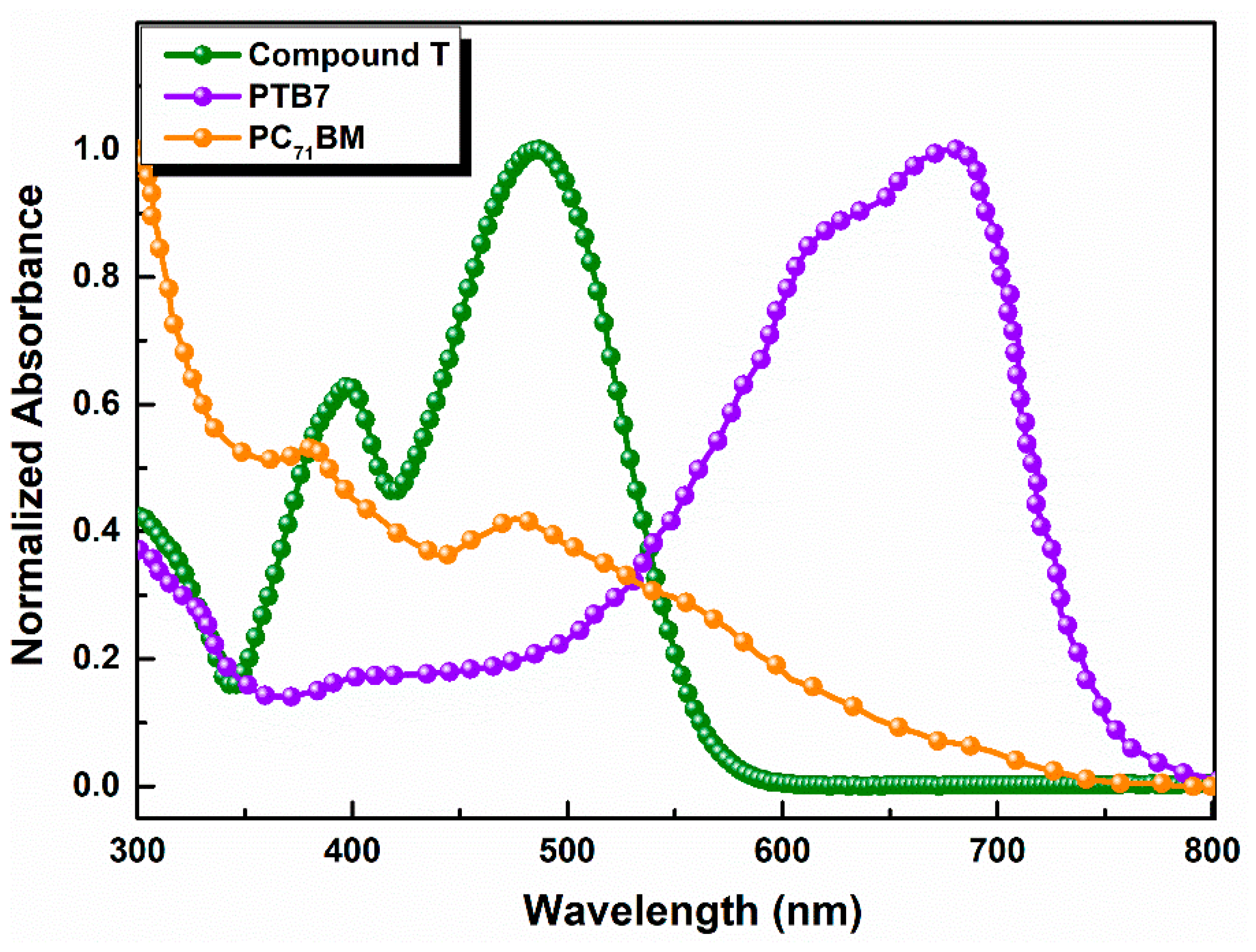
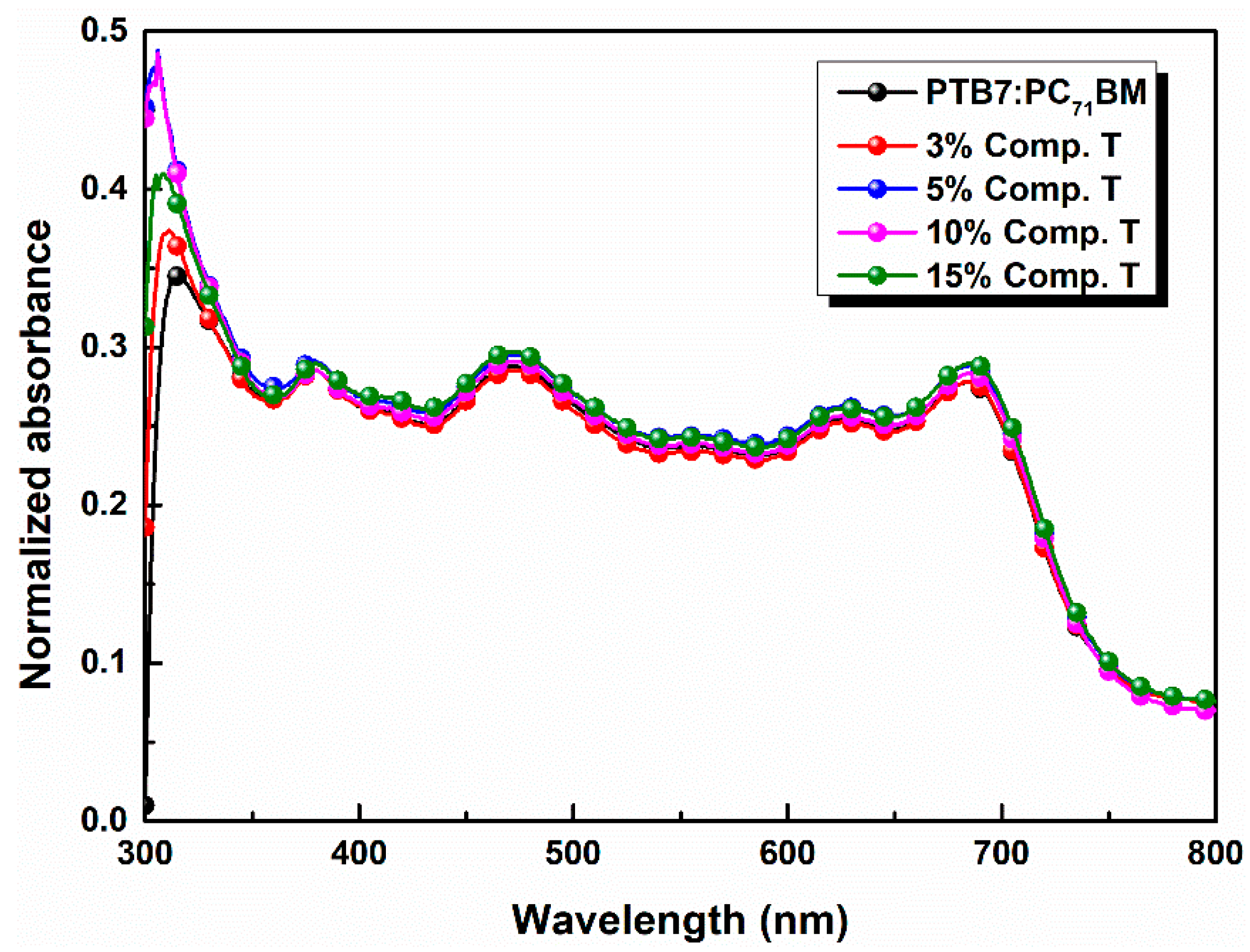
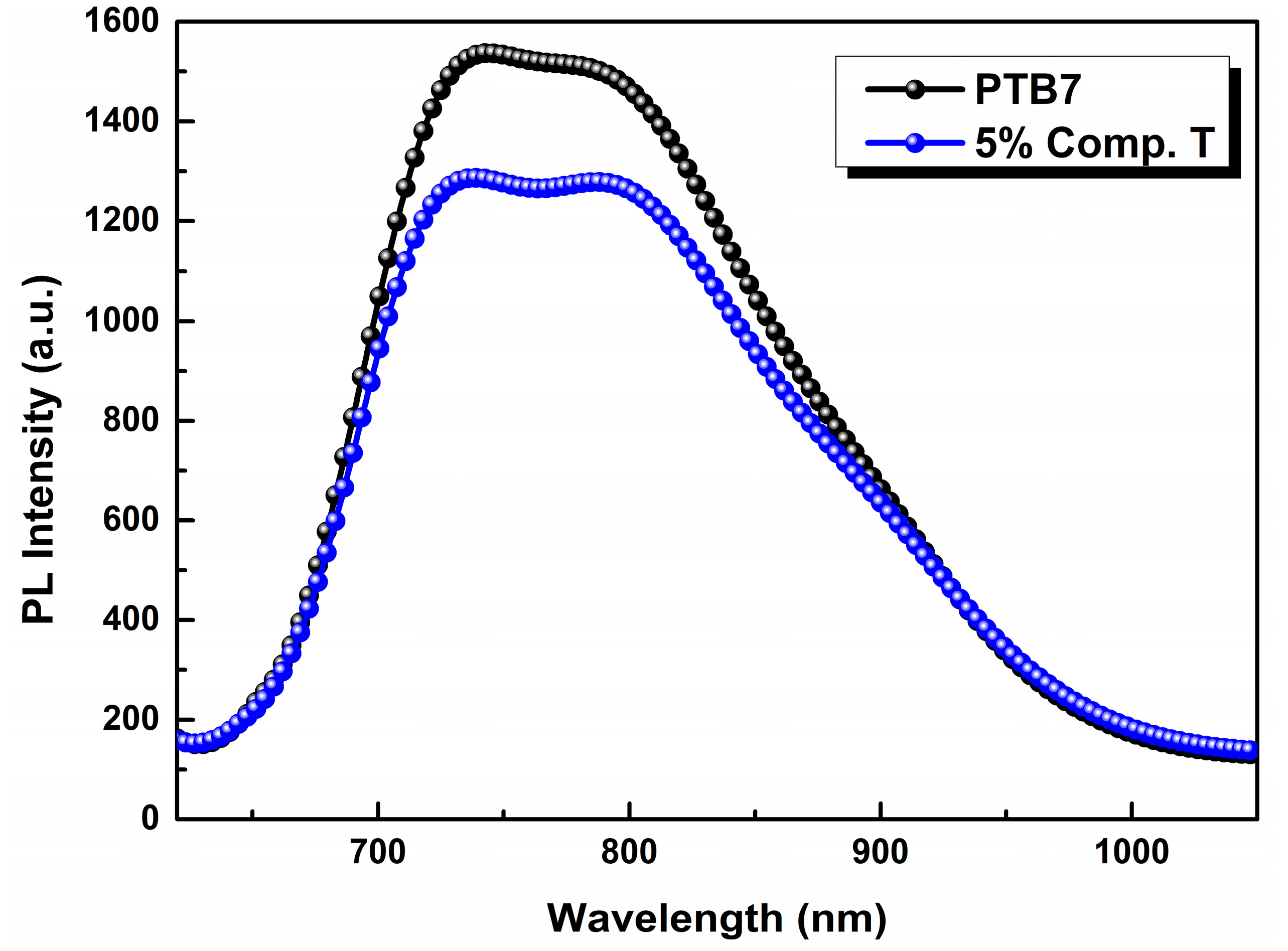

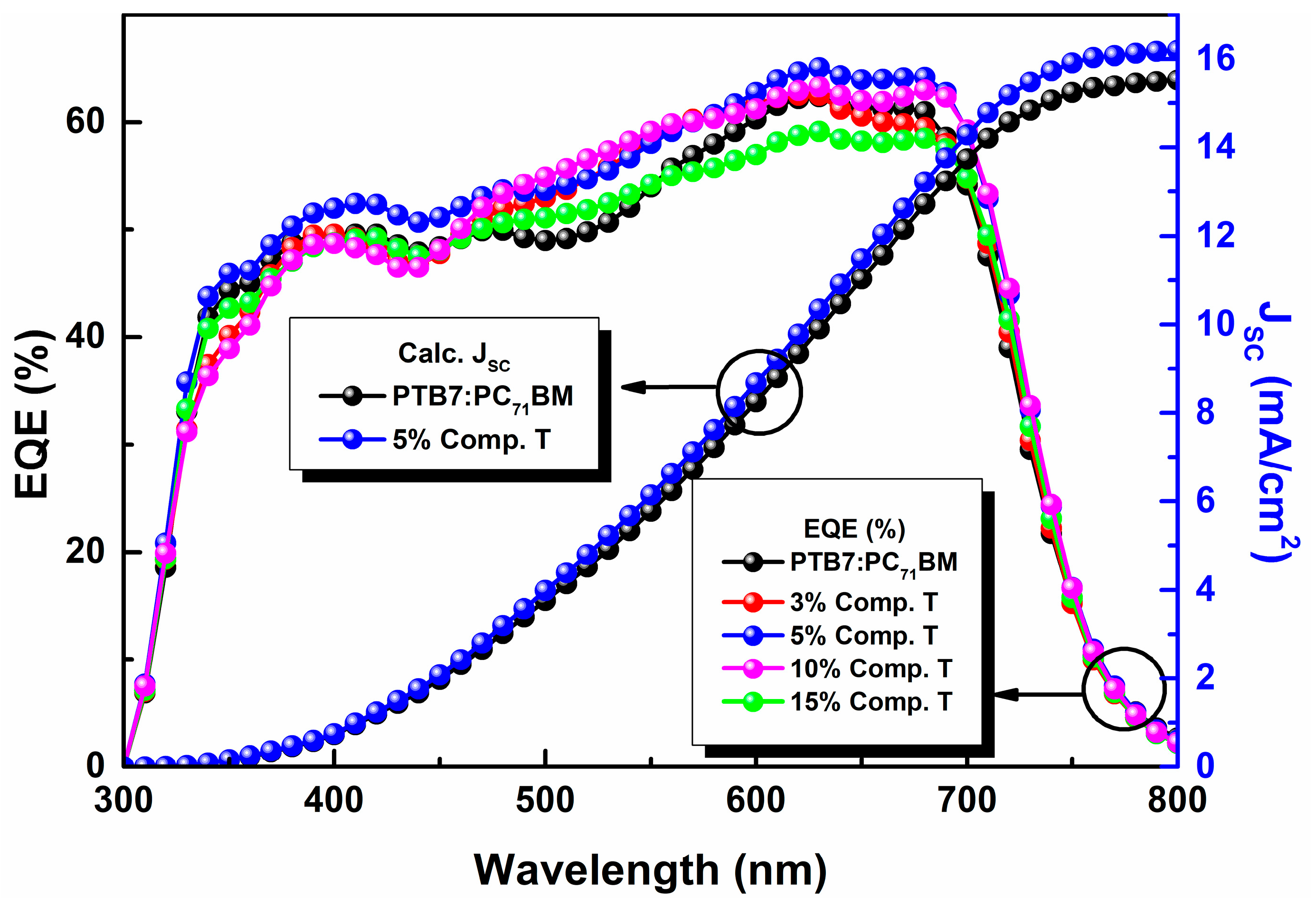
| Concentration of Compound T | Calc. Jsc (mA cm−2) | Jsc (mA cm−2) | Voc (V) | FF (%) | PCE (%) |
|---|---|---|---|---|---|
| Reference | 15.62 | 16.10 ± 0.08 | 0.72 ± 0.04 | 64.6 ± 0.6 | 7.51 ± 0.12 |
| 3% v/v | 16.00 | 16.44 ± 0.11 | 0.73 ± 0.02 | 65.9 ± 0.3 | 7.96 ± 0.11 |
| 5% v/v | 16.20 | 16.70 ± 0.05 | 0.73 ± 0.01 | 67.7 ± 0.4 | 8.25 ± 0.09 |
| 10% v/v | 15.58 | 16.06 ± 0.11 | 0.73 ± 0.02 | 64.0 ± 0.3 | 7.50 ± 0.11 |
| 15% v/v | 15.14 | 15.61 ± 0.13 | 0.72 ± 0.01 | 63.3 ± 0.1 | 7.11 ± 0.09 |
| Active Layer | μh (cm2·V−1·s−1) | μe (cm2·V−1·s−1) | Ratio (μh/μe) |
|---|---|---|---|
| PTB7:PC71BM (reference) | 9.91 × 10−5 | 8.01 × 10−5 | 1.24 |
| 5% compound T | 1.01 × 10−4 | 8.61 × 10−5 | 1.17 |
© 2020 by the authors. Licensee MDPI, Basel, Switzerland. This article is an open access article distributed under the terms and conditions of the Creative Commons Attribution (CC BY) license (http://creativecommons.org/licenses/by/4.0/).
Share and Cite
Krassas, M.; Polyzoidis, C.; Tzourmpakis, P.; Kosmidis, D.M.; Viskadouros, G.; Kornilios, N.; Charalambidis, G.; Nikolaou, V.; Coutsolelos, A.G.; Petridis, K.; et al. Benzothiadiazole Based Cascade Material to Boost the Performance of Inverted Ternary Organic Solar Cells. Energies 2020, 13, 450. https://doi.org/10.3390/en13020450
Krassas M, Polyzoidis C, Tzourmpakis P, Kosmidis DM, Viskadouros G, Kornilios N, Charalambidis G, Nikolaou V, Coutsolelos AG, Petridis K, et al. Benzothiadiazole Based Cascade Material to Boost the Performance of Inverted Ternary Organic Solar Cells. Energies. 2020; 13(2):450. https://doi.org/10.3390/en13020450
Chicago/Turabian StyleKrassas, Miron, Christos Polyzoidis, Pavlos Tzourmpakis, Dimitriοs M. Kosmidis, George Viskadouros, Nikolaos Kornilios, George Charalambidis, Vasilis Nikolaou, Athanassios G. Coutsolelos, Konstantinos Petridis, and et al. 2020. "Benzothiadiazole Based Cascade Material to Boost the Performance of Inverted Ternary Organic Solar Cells" Energies 13, no. 2: 450. https://doi.org/10.3390/en13020450
APA StyleKrassas, M., Polyzoidis, C., Tzourmpakis, P., Kosmidis, D. M., Viskadouros, G., Kornilios, N., Charalambidis, G., Nikolaou, V., Coutsolelos, A. G., Petridis, K., Stylianakis, M. M., & Kymakis, E. (2020). Benzothiadiazole Based Cascade Material to Boost the Performance of Inverted Ternary Organic Solar Cells. Energies, 13(2), 450. https://doi.org/10.3390/en13020450







